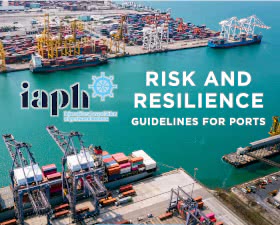
The International Association of Ports and Harbors (IAPH) has New risk and resilience guidance for ports and has created a new internet portal to catalog the risks and to share best practices for mitigating and managing risks to ports. The initiative follows the experience accumulated with the worldwide spread of the COVID-19 pandemic, which IAPH had addressed by setting up a special task force to provide support to ports in the acute phase of the health crisis. In Occasion of this crisis, which - as had never happened in precedence - focused on risks and resilience in particular of ports, whose users expect continue to operate regardless of adversity, IAPH World Ports guidelines had been defined Sustainability Program based on best practices acquired in particular in Asian ports. This experience had Induced the International Association of Ports to establish a its own Risk and Resilience Committee.
 The new guidelines have been developed by a team of experts and members of the association who are members of the Risk and IAPH Resilience Committee and aim to support leads in the definition of a structured approach to management of risk. The new portal, on the other hand, aims to allow a mutual learning by exploiting the experiences of ports that have faced or prepare to proactively face events and specific incidents.
The new guidelines have been developed by a team of experts and members of the association who are members of the Risk and IAPH Resilience Committee and aim to support leads in the definition of a structured approach to management of risk. The new portal, on the other hand, aims to allow a mutual learning by exploiting the experiences of ports that have faced or prepare to proactively face events and specific incidents.
The new portal, accessible at https://sustainableworldports.org/un-sdgs/, was conceived as a concrete and practical tool that can be applied by a port independently of its dimensions, its technical and infrastructural characteristics and its governance model. This tool defines and catalogs accurately the risks so that a port can assess the own ability to deal with them and perform an analysis of the its degree of risk preparedness, giving priority to the most likely events that could impact your operativity. Another important aspect is the definition of port stakeholders and planning of their management, so that a port can evaluate its own ability to control and influence them, and take into account the internal factors that affect on the activity of the port and assess the impacts on portal operations and on the wider repercussions on the economy and society. In addition, the portal supports a port to define the level of resilience in the own context by evaluating different basic elements of resilience necessary before, during, and after an event occurs. Among the other factors taken into account are environmental ones, such as the effect of flooding on ports, and those technology, including accidents caused by spills hydrocarbons.